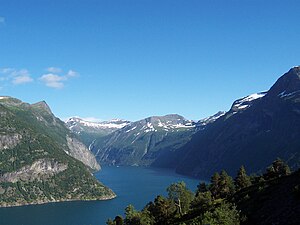Western Norway
Vestlandet (Norwegian) | |
|---|---|
 | |
 | |
| Country | Norway |
| County capitals | Bergen Molde Stavanger |
| Counties (fylker, fylke) | Møre og Romsdal Vestland Rogaland |
| Area | |
| • Total | 58,582 km2 (22,619 sq mi) |
| • Land | 55,411 km2 (21,394 sq mi) |
| Population (2020 est.) | |
| • Total | 1,499,900 |
| • Density | 26/km2 (66/sq mi) |
| Demonym | Vestlending |
| Nominal GDP (2013) | $57 billion |
| Nominal GDP per capita (2013) | $41,000 |
| Website | Vestlandsrådet |
Western Norway (Bokmål: Vestlandet, Vest-Norge; Nynorsk: Vestlandet, Vest-Noreg) is the region along the Atlantic coast of southern Norway. It consists of the counties Rogaland, Vestland, and Møre og Romsdal. The region has no official or political-administrative function. The region has a population of approximately 1.4 million people. The largest city is Bergen and the second-largest is Stavanger. Historically the regions of Agder, Vest-Telemark, Hallingdal, Valdres, and northern parts of Gudbrandsdal have been included in Western Norway.[1][2]
Western Norway, as well as other parts of historical regions of Norway, shares a common history with Denmark, the Faroe Islands and Iceland and to a lesser extent the Netherlands and Britain. For example, the Icelandic horse is a close relative of the Fjord horse and both the Faroese and Icelandic languages are based on the Old West Norse.
In early Norse times, people from Western Norway became settlers at the Western Isles in the Northern Atlantic, Orkney, Shetland, the Faroe Islands and Iceland. During the Viking Age settlements were made at the Hebrides, Man and Ireland proper.
In early modern times, Western Norway experienced much emigration to the United States, Canada, and to a lesser extent to the United Kingdom. This applies particularly to the US states of Minnesota, North and South Dakota, Wisconsin, Montana, and the Canadian province of Manitoba. The Icelandic and Faroese people, and many people in the British Isles, are descendants of Norsemen and Vikings who emigrated from Western Norway during the Viking Age. On the other hand, thousands of Western Norwegians are descendants of Dutch and German traders who arrived in the 16th and the 17th centuries, especially in Bergen. [3]
Vestland is also the name of a county consisting of two former counties, viz. Hordaland and Sogn og Fjordane.[4] The two counties were re-merged after having been split in 1763 (then called Søndre Bergenhus and Nordre Bergenhus, respectively).
- ^ "Vestlandet (Store norske leksikon)". Snl.no. 28 July 2011. Retrieved 17 October 2011.
- ^ Helle, Knut (2006). Vestlandets historie. Bergen, Norway: Vigmostad & Bjørke. ISBN 978-82-419-0400-4.
- ^ "Statistisk sentralbyrĺ: Arbeid – temaside" (in Norwegian). Ssb.no. Retrieved 17 October 2011.
- ^ "Dette er Norges nye regioner". www.vg.no.